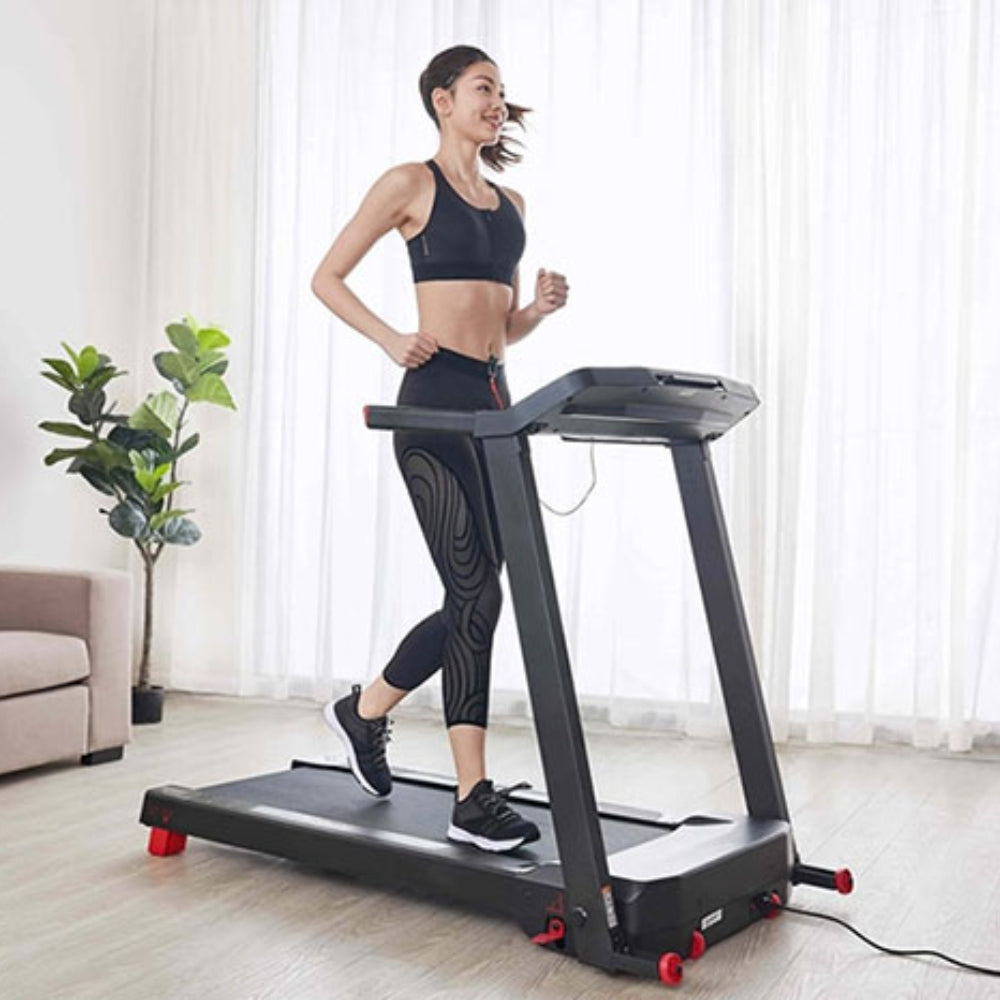Exercising at home offers convenience and privacy, making it easy to maintain your fitness routine. However, whether you need to wear shoes when exercising at home is still a question that many people wonder about. So, let's find out with Shondo through the following article!
1. Do I need to wear shoes when exercising at home?
Whether you should wear shoes when exercising at home depends on the type of exercise you do and the surface you work on. Here are some reasons and tips to help you decide whether or not to wear shoes:
1.1. When do you need to wear shoes when exercising at home?
There are many benefits to wearing shoes when exercising at home, especially when you are doing high-intensity interval training (HIIT) or on hard floors. Benefits of wearing shoes include:
- Foot and ankle protection: Sports shoes support shock absorption, limit pressure on the feet and ankles, especially when performing jumping and bouncing movements, helping to avoid unnecessary injuries.
- Improve workout performance: Sports shoes help you maintain better balance, move more flexibly, support difficult movements, thereby increasing the effectiveness of your workout.
- Suitable for certain types of floors: If your floor is made of concrete, ceramic tile or hardwood, wearing shoes will help protect your feet from friction and slipping.
- Support for people with a history of injury: For people who have had a foot injury, wearing supportive sports shoes helps stabilize the joint, reducing the risk of re-injury.
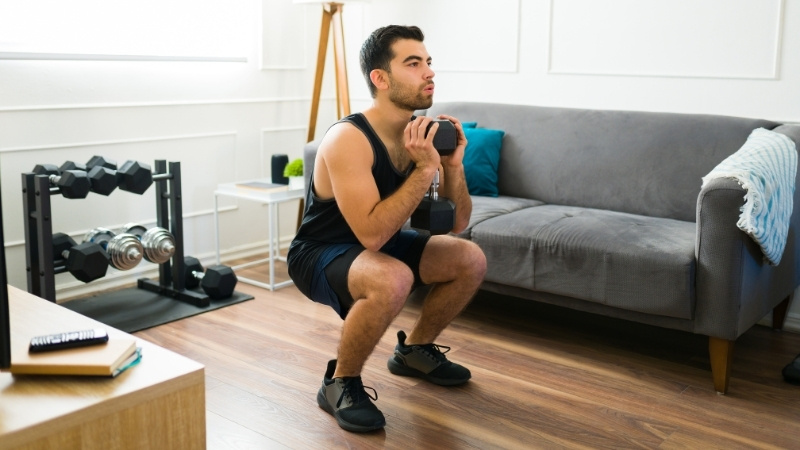 You should wear shoes when doing HIIT exercises, hard floors,...[/caption]
You should wear shoes when doing HIIT exercises, hard floors,...[/caption]
Some suitable shoes:
- Sports shoes: Suitable for high intensity exercises with lots of movement.
- Running shoes: Suitable for jogging in place, running on the machine.
1.2. When do you not need to wear shoes when exercising at home?
Exercises such as yoga and pilates are often recommended to be practiced barefoot to increase flexibility and feel the movements. Exercising barefoot also has benefits such as:
- Increase foot strength and flexibility: Exercising barefoot helps the small muscles in the feet work more, increasing strength and flexibility.
- Improved balance: Direct contact with the floor helps your body react more quickly, improving your balance.
- Enhanced ground awareness: Practicing barefoot helps you better sense your body's center of gravity and the position of your feet, supporting correct posture adjustment.
- Create comfort: Many people feel more comfortable and relaxed when exercising barefoot, especially with exercises like yoga and pilates.
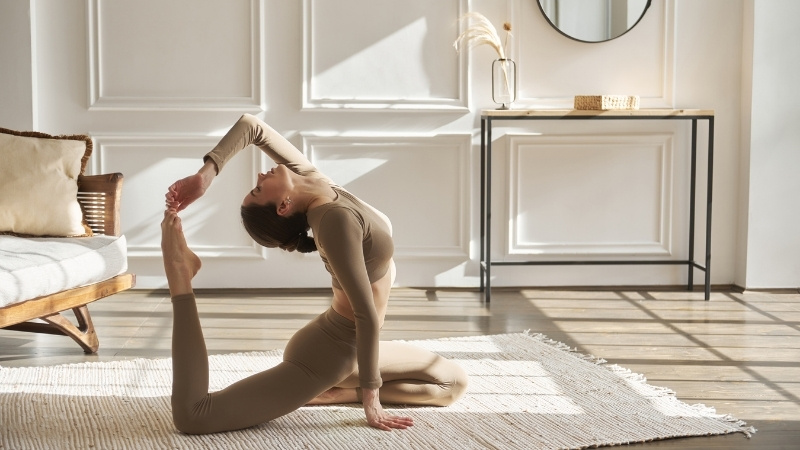 Yoga is encouraged without shoes when practicing[/caption]
Yoga is encouraged without shoes when practicing[/caption]
Note: Consult a professional or trainer before deciding to train barefoot, especially if you have a history of injury.
In short, when doing high-intensity exercises on hard floors, you should wear shoes. You can wear no shoes or less shoes when doing yoga and Pilates.
2. Factors that determine whether you should wear shoes or exercise barefoot
To decide whether to wear shoes or exercise barefoot, you need to consider the following factors:
- Type of exercise: High intensity exercises, vigorous movements, lots of jumping movements should wear sneakers. Gentle, static exercises such as yoga, Pilates can be done barefoot.
- Exercise floor surface: The floor is hard and slippery, so wear shoes to protect your feet. The floor is soft and has a mat so you can exercise barefoot.
- Physical condition and injury history: People with a history of foot injuries, overweight people, and people who are new to exercise should wear shoes to support and protect their feet.
- Personal opinion: Listen to your body and choose the option that makes you feel most comfortable and confident.
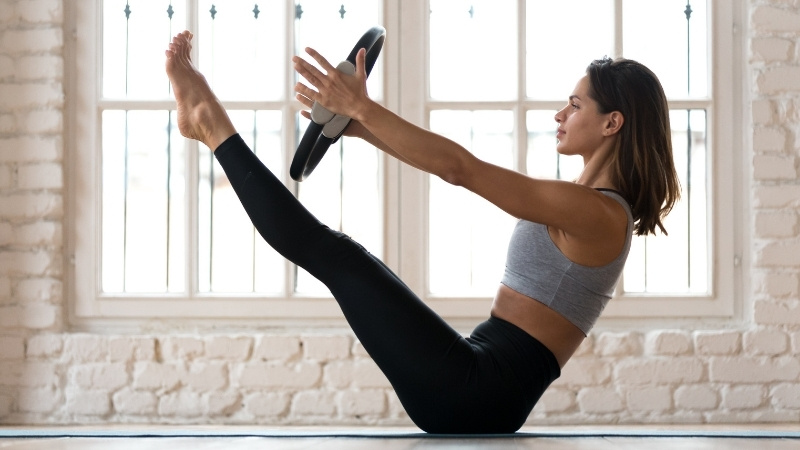 Pilates exercises are quite gentle so do not wear shoes when practicing[/caption]
Pilates exercises are quite gentle so do not wear shoes when practicing[/caption]
3. Notes when exercising at home
Whether you choose to exercise with or without shoes, keep the following in mind to ensure safety and effectiveness:
- Warm up thoroughly before exercising: Warming up helps warm up the body, prepare for the main exercises, and reduce the risk of injury.
- Choose comfortable, sweat-absorbent clothing: Comfortable clothing helps you move easily, sweat-absorbent material helps the body stay dry and comfortable.
- Drink enough water before, during and after exercise: Adequate hydration helps the body function effectively and avoid dehydration.
- Listen to your body, stop when you feel pain or fatigue: Don't try to overdo it, rest when needed.
- Practice correct posture to avoid injury: Correct posture helps you exercise more effectively and safely.
- Exercise regularly for best results: Maintaining a regular exercise routine is key to good results.
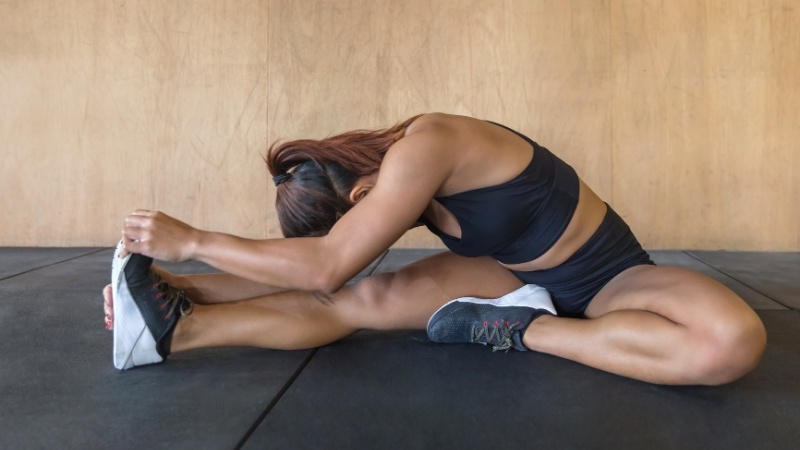 Warm up helps warm up the body[/caption]
Warm up helps warm up the body[/caption]
4. Suggest some exercises at home without wearing shoes
Practicing yoga at home is a great option for those who want to improve their health, increase flexibility, and relax their mind without having to wear shoes. Here are some basic yoga poses you can do:
4.1. Mountain Pose Yoga
Mountain pose improves posture, strengthens the legs, and helps balance the body. It is the foundation for many other yoga poses, and helps relax the mind and increase concentration.
Instructions:
- Step 1: Stand straight with feet parallel.
- Step 2: Relax your arms along your body, palms facing inward.
- Step 3: Focus on your breathing and feel the balance in your body. Hold the pose for 30 seconds.
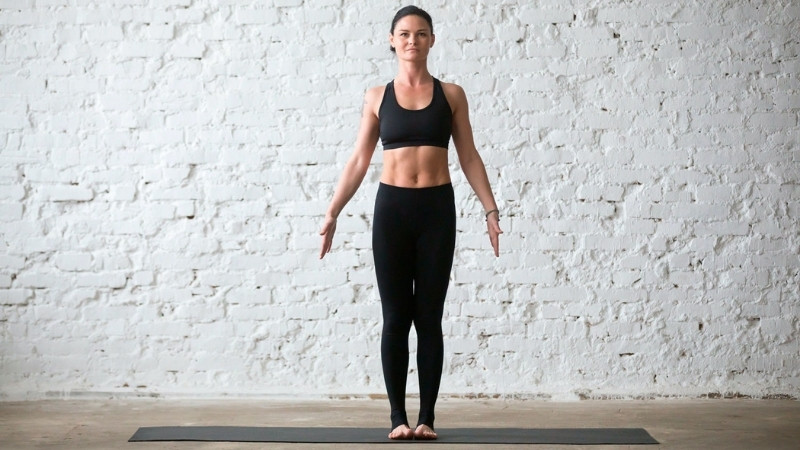 Yoga Mountain Pose[/caption]
Yoga Mountain Pose[/caption]
4.2. Yoga warrior pose
Warrior pose strengthens the legs, arms, and shoulders, improves stamina, and makes the body more flexible. It also opens the chest and boosts confidence.
Instructions:
- Step 1: Start by standing straight, then step your left foot back.
- Step 2: Turn your left foot to the side at a 45 degree angle, keeping your right foot facing forward.
- Step 3: Inhale, raise both arms parallel to the floor, palms facing down.
- Step 4: Lower your right knee so your thigh is parallel to the floor, creating a 90-degree angle.
- Step 5: Hold the position for 30 seconds to 1 minute, then switch legs and repeat.
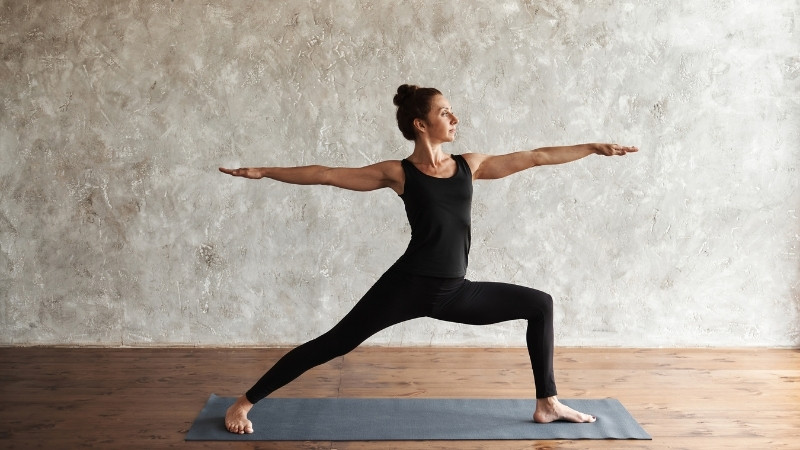 Yoga warrior pose[/caption]
Yoga warrior pose[/caption]
4.3. Yoga triangle pose
Triangle pose stretches the thighs, hips, and spine, increases flexibility, and improves balance. It also opens the chest and improves breathing.
Instructions:
- Step 1: Stand up straight, feet twice shoulder width apart.
- Step 2: Turn your right foot 90 degrees to the right, and turn your left foot slightly inward.
- Step 3: Inhale, raise both arms to shoulder level.
- Step 4: Exhale, bend towards your right leg and place your right hand on your ankle, shin, or touching the floor.
- Step 5: Point your left hand toward the ceiling, eyes following your left hand. Hold for 30 seconds to 1 minute, then switch sides.
 Yoga triangle pose[/caption]
Yoga triangle pose[/caption]
4.4. Yoga tree pose
Tree pose helps to increase strength and flexibility in the legs, improve balance and increase concentration. It is also a relaxing exercise that helps to improve concentration.
Instructions:
- Step 1: Stand up straight with your feet together.
- Step 2: Place the sole of your right foot on the inner thigh of your left leg (or lower leg if you are not yet steady), keeping your balance.
- Step 3: Inhale, raise both arms up and clasp them in front of your chest or raise them above your head.
- Step 4: Keep your balance and focus on a fixed point. Hold the position for 30 seconds to 1 minute, then switch legs.
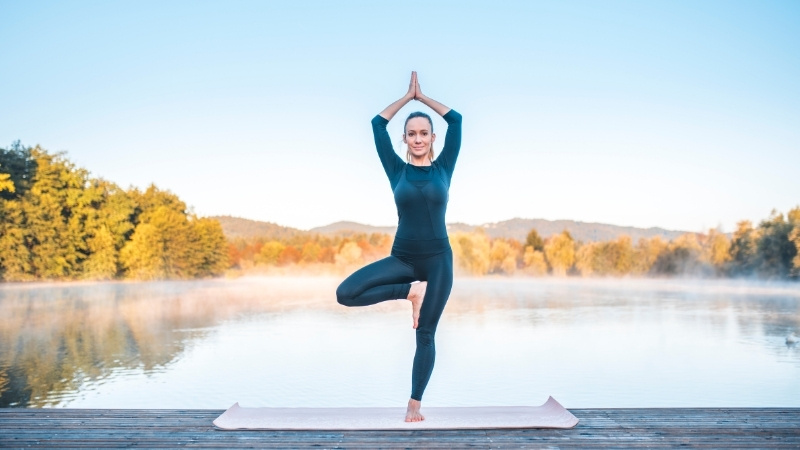 Yoga tree pose[/caption]
Yoga tree pose[/caption]
5. Related questions
5.1. Do I need to warm up properly when exercising at home?
Besides finding out whether you need to wear shoes when exercising at home. Warming up thoroughly before exercising at home is extremely important, no matter what exercise you do, at what intensity.
Warming up helps warm up the body, increase blood circulation, make muscles and joints more flexible, and reduce the risk of injury. Some simple warm-up movements include rotating wrists and ankles, jogging in place, jumping rope...
5.2. What is the best time to exercise at home?
The best time to exercise is when you feel most relaxed and energized. However, you should avoid exercising too late in the evening as it can affect your sleep.
5.3. Is exercising at home as effective as exercising at the gym?
Both working out at home and working out at the gym have their own advantages and disadvantages. Working out at the gym has many machines and supporting tools, helping you to exercise more diversely and effectively. However, working out at home is convenient, saves costs and travel time.
The effectiveness of your workout depends on your persistence and effort, not entirely on where you workout.
[caption id="attachment_6545" align="aligncenter" width="800"]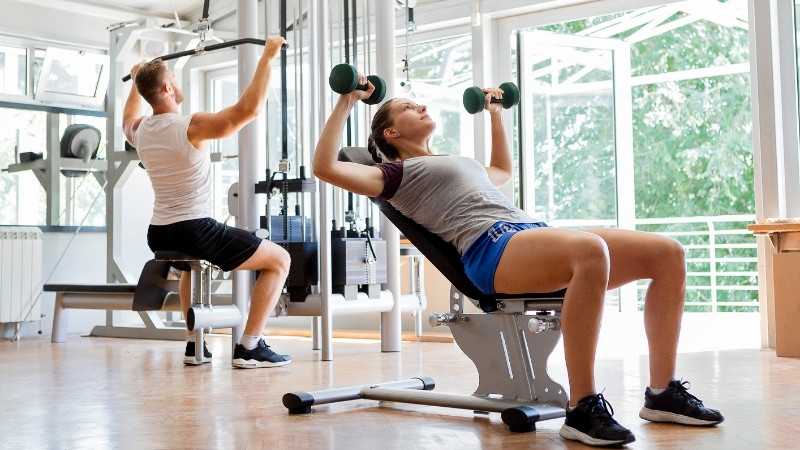 The effectiveness of exercise depends on perseverance and effort[/caption]
The effectiveness of exercise depends on perseverance and effort[/caption]
Whether or not you need to wear shoes when exercising at home depends on many factors such as the type of exercise, the surface of the floor, your physical condition and your personal feelings. Choose the most suitable option to protect your feet and improve the effectiveness of your workout.
Related Articles

Nếu bạn đã và đang sở hữu cho mình đôi giày ballet sneaker nhưng vẫn chưa biết outfit nào phù hợp. Xem ngay bài viết này với 5 cách phối đồ với giày ballet sneaker đẹp không có điểm trừ cùng Shondo...

Squid Game 3 chính thức khuấy đảo trên màn ảnh, bạn đã sẵn sàng ngồi liền 6 tập để xem cuộc chiến sinh tồn lần cuối của Gi-Hun chưa? Dưới đây là combo cuối tuần “chuẩn sinh tồn hiện đại” mà Shondo ...

Phong cách Retro là gì mà được nhiều người săn đón như vậy? Cùng Shondo tìm hiểu qua bài viết sau đây để biết thêm nhiều điều thú vị từ điểm đặc trưng cho đến cách phối đồ như thế nào là chuẩn nhé....

Một trong những trào lưu nổi bật gây sốt trên các cộng đồng yêu thời trang chính là phong cách Maillard. Nhưng điều gì khiến chúng lại có sức hút lớn đến như vậy? Shondo sẽ giúp bạn hiểu rõ hơn về...

Áo Polo nữ - item nghe thì tưởng già nhưng thực ra lại đang quay trở lại mạnh mẽ. Từ sân golf đến sân trường, từ văn phòng đến quán cafe, chiếc áo đơn giản với cổ bẻ đặc trưng này bỗng trở nên đa n...
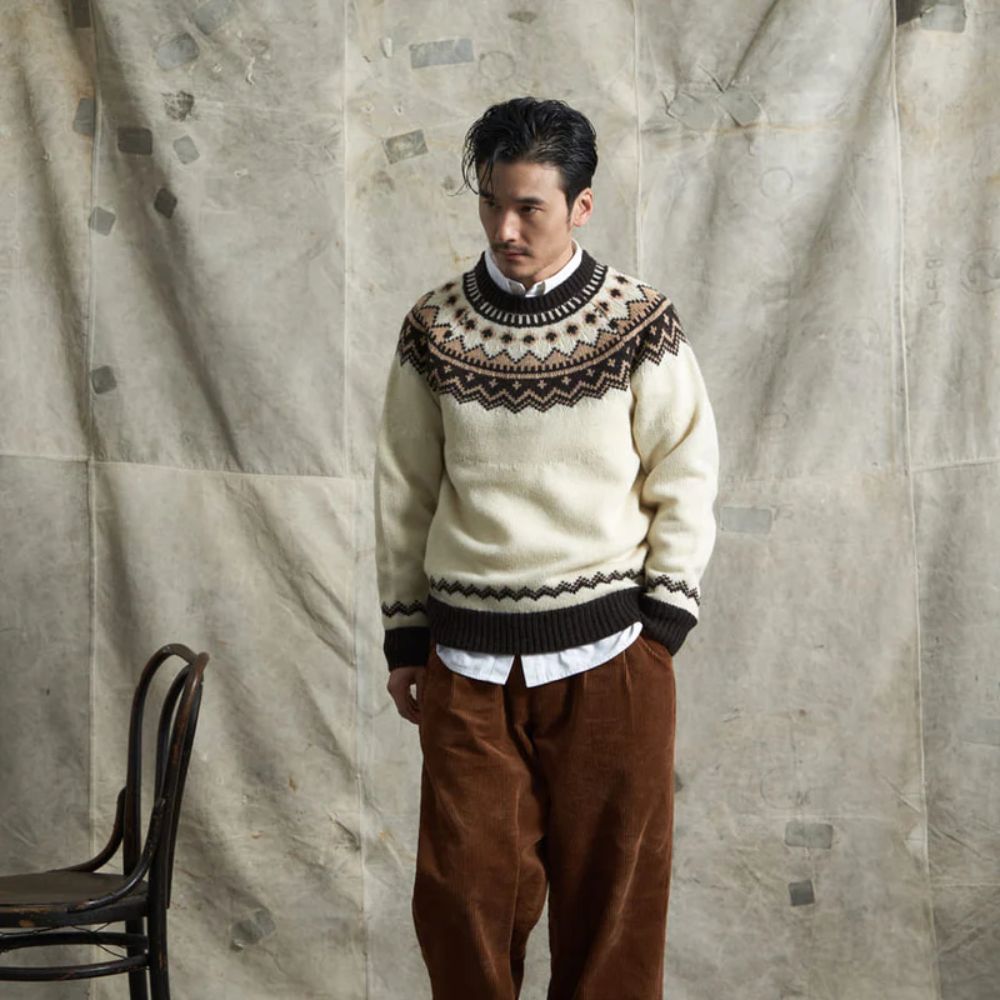
Phối đồ Vintage trong giới thời trang mang đến những nét độc đáo rất riêng. Phong cách này trở thành xu hướng phổ biến không chỉ ở nữ mà còn xuất hiện nhiều ở nam giới. Shondo sẽ cho bạn thấy điều ...

